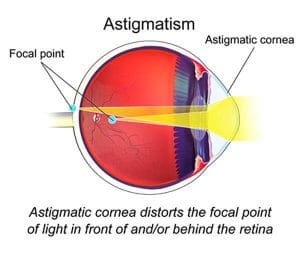Eye Astigmatism is a word that a lot of people have heard of, but not many actually understand. Although it’s a big and complicated-sounding word, the truth is that astigmatism is more simple than you might think. It simply means that your eye isn’t as round as it should be.
Although a lot of people assume that astigmatism is a rare problem. The truth is that most of us have it to some degree. The vast majority of people don’t have a perfect eyeball – shaped like a round ball. A perfect eye would be one that can perfectly bend and shape light to give you a clear view. However, if your eye isn’t shaped as much like a ball as it should be. Then the light you absorb into your vision ends up getting bent into one direction or another.
When light can’t be focused properly by your eye. The images that you look at get more focus in one area than they do in others. This could mean that objects at a distance are more likely to look blurry.
Eye astigmatism doesn’t have to be a frightening concept. As we mentioned above, it’s very common, and most people are born with this problem. Even if you’re born with perfect eyes, there’s always a chance that you can get astigmatism after a surgery, injury, or specific disease. Here, we’re going to discuss the facts about astigmatism.
Diagnosing Eye Astigmatism

Eye astigmatism is one of a group of conditions affecting the eye called a “refractive error”. These issues happen when the lens or cornea in your eye isn’t perfectly curved and smooth. There are various different types of refractive error, including nearsightedness, farsightedness and more. Around half of the adults in the US have some kind of refractive error in their vision.
Diagnosing eye astigmatism can sometimes be difficult with children, many children born with this condition don’t realize that they have it until their eyes are tested. That’s why it’s so important for people of all ages to regularly visit an eye professional. When opticians need to test for astigmatism, they might use:
- Astigmatic dials: This is a chart showing a series of lines making up a semi-circle. People with astigmatism will see some lines more clearly than others.
- Visual acuity: This is a test that involves reading letters on a piece of paper presented at a distance. The letters get smaller the further down the chart you go.
- Keratometer: This is a device that opticians can use to measure the amount of refractive light bouncing off the surface of the cornea. The keratometer measures the radius of the cornea and assesses the degree of abnormal curve.
- Corneal topography: This is a process that provides the optician with more information about the shape of the eye.
What are the Symptoms of Eye Astigmatism?
If you’re concerned that astigmatism problems run in your family, then you might find it helpful to be aware of the symptoms of this condition, so you can contact an expert as soon as you start to notice problems. Common signs of eye astigmatism include:
- Frequent squinting
- Headaches and migraines
- Distorted or blurred vision
- Eye strain or pain
Although you don’t always have astigmatism if you have these symptoms, it’s always a good idea to make sure that you know what’s going on with an eye test. Remember that astigmatism can also cause blurry vision because the light in your eye can’t be refracted properly. Sometimes, if the astigmatism in your eyes is severe, then you might even see double vision.
Treatment for Astigmatism
Although astigmatism is a common problem for people all around the world, the good news is that it is also very easy to treat. If your astigmatism error is mild, then your doctor might suggest using no treatment at all. On the other hand, if your problem is causing you some discomfort, then your optician will generally consider corrective lenses or eyeglasses.
The lenses available either on your contact lenses or eyeglasses can help to bend the incoming rays of light that enter your eye for you, so that you can get a clearer image of the world around you. Keep in mind that the lenses you receive for astigmatism will need a more complex prescription than the average eyeglasses.
Your lenses will need a spherical power which corrects your issue of far or near-sightedness. At the same time, you will also need a cylindrical power on your prescription to deal with the astigmatism issue, and an axis that describes the way your eye is positioned.
An alternative option to eyeglasses and contact lenses is corneal refractive therapy or CRT. This involves a process of wearing specially fitted lenses to help reshape the cornea. This will not repair your vision permanently, but it can make life easier.
Getting Surgery for Eye Astigmatism
If you want a permanent cure for eye astigmatism and you don’t like wearing glasses or contact lenses, then you may be able to consider alternative options like laser eye surgery or laser vision correction. The most common form of eye surgery for astigmatism is LASIK. In LASIK, your doctor will use a device known as a keratome to make a thin incision into your cornea. When the incision is made, the doctor will lift the flap that they make in your eye and shape the cornea with a laser instrument.
There are other forms of laser surgery available that might be suitable for people who aren’t capable of getting LASIK. For instance, PRKis a good option for people who would need to have the lens removed during surgery. Your eye will repair itself naturally over time, although you will need a special lens to keep the eye clear while it is healing.
Although many people are suitable for laser surgery to help repair refractive eye issues, it’s important to speak to your doctor about your options. Some people will not be suitable for this kind of treatment, and it will depend largely on the degree of astigmatism you suffer from, alongside other factors too.























